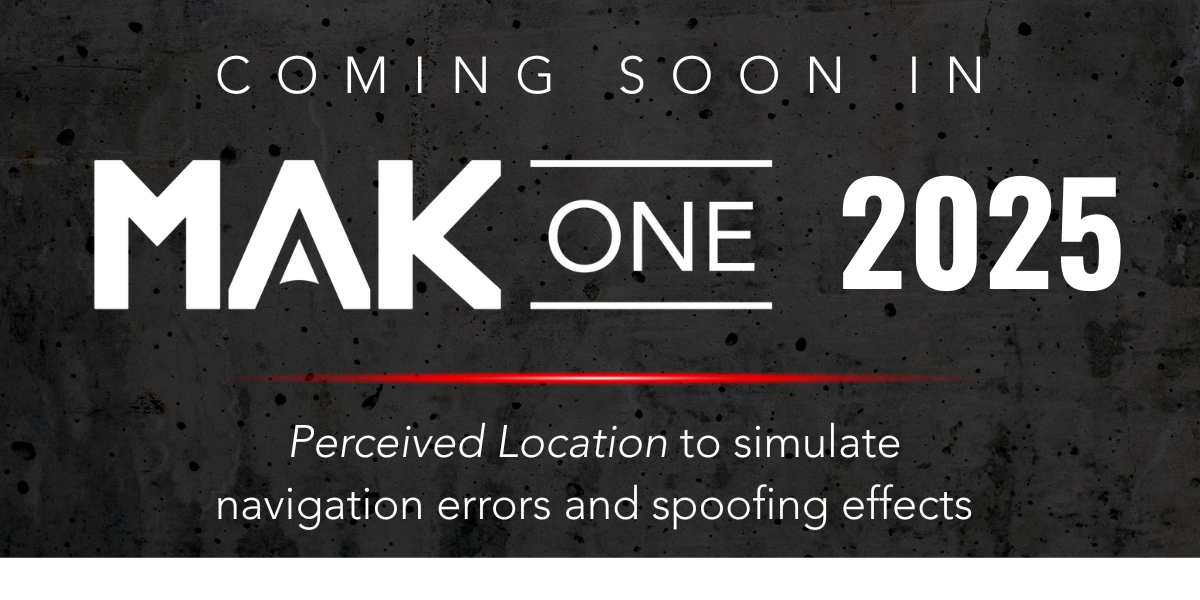
MAK ONE 2025: Now with more error!
By Jim Kogler
When you build a CGF like VR-Forces, you spend a lot of time worrying about errors. With millions of lines of code trying to simulate everything from the bottom of the ocean to space, there is a lot that can go wrong. Most of our work focuses on making sure the right simulated entities go to the right places at exactly the right time. This year, we spent some time thinking about how to get entities to go to the wrong places—and we know much of the modeling and simulation industry is thinking about that too.
VR-Forces 5.2 introduces a concept we call perceived location. The perceived location is where the vehicle believes it is, not the ground truth. While much of the RPR FOM and NETN focuses on ground truth, for many autonomous systems—and even some manned systems—the perceived location is more important than the actual one; navigation decisions are usually taken on where you think you are, not always on where you actually are.
Every vehicle uses a combination of systems to determine its position. For manned systems, that might be as simple as looking out the window. Many systems rely on GPS; others may use inertial navigation models or visual terrain matching. Systems that depend heavily on electronic position-finding methods like GPS are increasingly vulnerable to spoofing and signal degradation by adversaries. That leads to error. Sometimes the error results from data drift or poor signal; in other cases, it stems from deliberate interference or manipulation.
With this new release, VR-Forces Air entities will model both ground truth and perceived location, and all plugins and extensions will have access to that data. Customers can also manipulate the perceived location through the API by creating jammers and spoofers. Tasked entities will then use the perceived location for navigation. As the perceived location diverges from ground truth, entities will respond accordingly.
Open APIs Make This Powerful
Thanks to VR-Forces' Open API, this feature is especially powerful. Most research into spoofed navigation networks remains classified or experimental. VR-Forces contains no classified data; in fact, the MAK ONE suite is EAR-99, making it broadly exportable. However, many MAK customers build sophisticated and realistic systems that model the behavior of real equipment within VR-Forces.
VR-Forces was designed to be extended without MAK’s direct involvement. A user can create a plugin that models how a cruise missile determines its position using any combination of methods—terrain matching, GPS, inertial systems, and more. Once built, that system can apply to any air entity in VR-Forces. The same user could develop an EW jamming/spoofing transponder and add it to a ground vehicle. This setup allows the EW system to interfere with a target's location and, in turn, lets the target update its perceived location based on the spoofing effect, terrain, weather, or any other factors VR-Forces models.
And here’s the best part: if that user also buys a third-party plugin, such as CogSIM’s TDL simulator, it will automatically report the spoofed perceived location to the simulated TDL network. Thanks to the Open API, different users can build and deploy interoperable capabilities without having to coordinate every detail.
In the end, VR-Forces 5.2 represents a shift in how we think about simulation fidelity. By adding support for both ground truth and perceived location, and by enabling customers to model spoofing and error realistically, we are not only keeping up with emerging threats but empowering users to innovate. When Open APIs, modular design, and customer creativity come together, simulation moves from plausible to powerful.
Hungry for more?
Learn more about this and the rest of what's included in the MAK ONE 2025 release at our recent webinar "A First Look at What's Coming in MAK ONE" with Jim Kogler!

